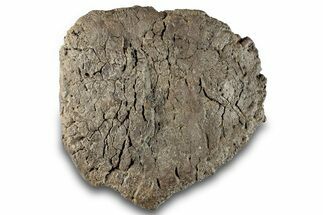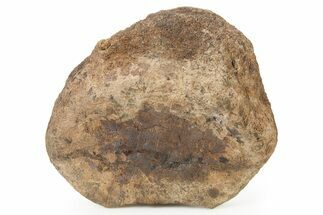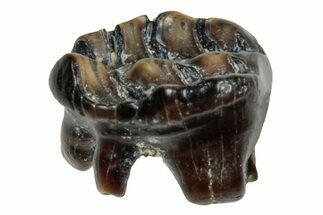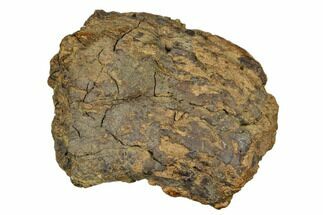This Specimen has been sold.
2" Fossil Ankylosaurid Osteoderm - Montana
This is a fossil ankylosaurid (Ankylosaurus magniventris or Denversaurus schlessmani) osteoderm (scute - armor plate) that was collected from the Hell Creek Formation on a private lease in Dawson County, Montana. It measures 2" wide.
It's very difficult to distinguish between the two ankylosaurid species' post-cervical osteoderms without knowing exactly what to look for.
Comes with a floating frame display case.
It's very difficult to distinguish between the two ankylosaurid species' post-cervical osteoderms without knowing exactly what to look for.
Ankylosaurus was the namesake of the Ankylosaurid family of dinosaurs to which it belonged, and one of the last ones to live before the Cretaceous-Paleogene extinction event 65 million years ago. Residing in western North America, Ankylosaurus was an herbivorous dinosaur with a low, squat body, a short neck with a square head, and a long tail ending with a large, bony club which it likely used for self-defense against predators like T.rex. Perhaps most notably, Ankylosaurus was one of the most heavily armored dinosaurs of all time. Ankylosaurs were known for their heavy bone armor all over the top half of their bodies, as well as bony knobs protruding all over their backs and face. Even their eyelids were protected against potential attack.
At adult size, these impenetrable behemoths measured about 25-30 feet and 4 to 8 tons. At that size, even an adult Tyrannosaurus would have had difficulty getting close enough to try and flip it to get at Ankylosaurus's less armored underbelly. Dinosaurs like Ankylosaurus prove indubitably that herbivores were just as impressive and dangerous as their carnivorous counterparts.
At adult size, these impenetrable behemoths measured about 25-30 feet and 4 to 8 tons. At that size, even an adult Tyrannosaurus would have had difficulty getting close enough to try and flip it to get at Ankylosaurus's less armored underbelly. Dinosaurs like Ankylosaurus prove indubitably that herbivores were just as impressive and dangerous as their carnivorous counterparts.
Denversaurus was a panoplosaurin nodosaurid dinosaur from the late Cretaceous, approximately 66 million years ago. Denversaurus was an herbivore like other nodosaurids/ankylosaurids, and measured approximately 20 feet (6 meters) on average. It lived in North America in the midwest alongside more well-known contemporaries such as Tyrannosaurus rex, Triceratops, and Pachycephalosaurus. Like other nodosaurids/ankylosaurids, it had an armored carapace made up of bony scutes all along the dorsal surface of its body.
Because of its age and sedimentary composition, the Hell Creek Formation has become one of the most paleontologically studied areas in the world. 158 genera of animals and 64 genera of plants are known from the formation and new discoveries are made frequently. In addition to Tyrannosaurs, Ceratopsids, and Hadrosaurs, the formation has yielded remains of amphibians, reptiles, lizards, snakes and turtles, fish and sharks, avian and non-avian dinosaurs, and mammals. The Hell Creek Formation gives the most complete understanding of the environment just before the Cretaceous-Paleogene extinction.
SPECIES
Ankylosaurus magniventris or Denversaurus schlessmani
LOCATION
Dawson County, Montana
FORMATION
Hell Creek Formation
SIZE
2 x 1.4 x .75"
CATEGORY
SUB CATEGORY
ITEM
#280951
We guarantee the authenticity of all of our
specimens. Read more about our
Authenticity Guarantee.
specimens. Read more about our
Authenticity Guarantee.
 Reviews
Reviews












